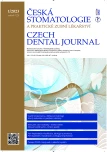MANUAL TOOTHBRUSHES – BRISTLES QUALITY
Authors:
K. Hynková 1,2; L. Pospíšilová 1; I. Voborná 1
Authors‘ workplace:
Klinika zubního lékařství, Lékařská fakulta Univerzity Palackého v Olomouci, a Fakultní nemocnice Olomouc
1; Asklepion – Institut klinické a estetické medicíny, Praha
2
Published in:
Česká stomatologie / Praktické zubní lékařství, ročník 123, 2023, 1, s. 11-17
Category:
Original articles
doi:
https://doi.org/10.51479/cspzl.2022.014
Overview
Introduction: Today's market offers to users a large number of manual toothbrushes in attractive colors, different head designs, handles, bristle cuts as well as softness, and various prices too. However, is an expensive, ecological, or brightly coloured toothbrush of a good quality and does it not harm us? A quality toothbrush is defined as a toothbrush whose bristles do not damage the gums or hard dental tissues. This study is focused on the quality of bristle ends processing. The aim is to show the reader and compare the bristle quality of six different products sold on our market.
Methods: Six toothbrushes from six different manufacturers were selected for this study: A. Curaprox 5460; B. Dr.Max PRO32 Extra soft 5400; C. Tepe Compact x – soft; D. Spokar X 5500 Ultrasoft; E. SOFTdent ECO Ultrasoft; F. Elmex Ultrasoft. Brushes were selected with the same parameters such as straight cutting and softness of the bristles. The quality of brush bristle ends was detected using stereo microscopy and electron microscopy.
Results: The selected manual brushes show a large discrepancy in the quality of the processing of the bristles not only in the comparison amongst the observed brushes, but the quality of the bristles is not consistent even within one observation of a single brush.
Conclusion: The observation clearly demonstrated a significantly higher quality of the bristles processing of the Tepe Compact x – soft brush compared to other brushes.
Keywords:
toothbrushes – manual – bristles quality – bristles ends
Sources
1. Kilian J. Prevence ve stomatologii. 2. vydání. Galén; Praha, 1999.
2. American Dental Association (ADA). A look at toothbrushes. J Am Dent Assoc. 2007; 138: 1288.
3. www.ada.org/resources/research/ science-and-research-institute/oral-healthtopics/ toothbrushes
4. Breitenmoser J, Mörmann W, Mühlemann HR. Damaging effects of toothbrush bristle end form on gingiva. J Periodontol. 1979; 50(4): 212–226. doi: 10.1902/jop.1979.50.4.212. PMID: 374707
5. Januar P, Susetyo A, Widyastuti R. The effectiveness of sharp end and rounded end bristle toothbrush. Dent J: Majalah Kedokteran Gigi. 2010; 43(3): 122–125.
6. Greggianin BF, Oliveira SC, Haas AN, Oppermann RV. The incidence of gingival fissures associated with toothbrushing: crossover 28-day randomized trial. J Clin Periodontol. 2013; 40(4): 319–326. doi: 10.1111/jcpe.12072 Epub 2013 Feb 21. PMID: 23425194
7. Zanatta FB, Bergoli AD, Werle SB, Antoniazzi RP. Biofilm removal and gingival abrasion with medium and soft toothbrushes. Oral Health Prev Dent. 2011; 9(2): 177–183.
Labels
Maxillofacial surgery Orthodontics Dental medicineArticle was published in
Czech Dental Journal

2023 Issue 1
Most read in this issue
- USE OF MIDAZOLAM IN PAEDIATRIC DENTISTRY
- MANUAL TOOTHBRUSHES – BRISTLES QUALITY
- PERI-IMPLANTITIS: CLASSIFICATION, ETIOLOGY AND PREVENTION
- ČASOPIS ČSPZL: NOVÝ WEB A REDAKČNÍ SYSTÉM
